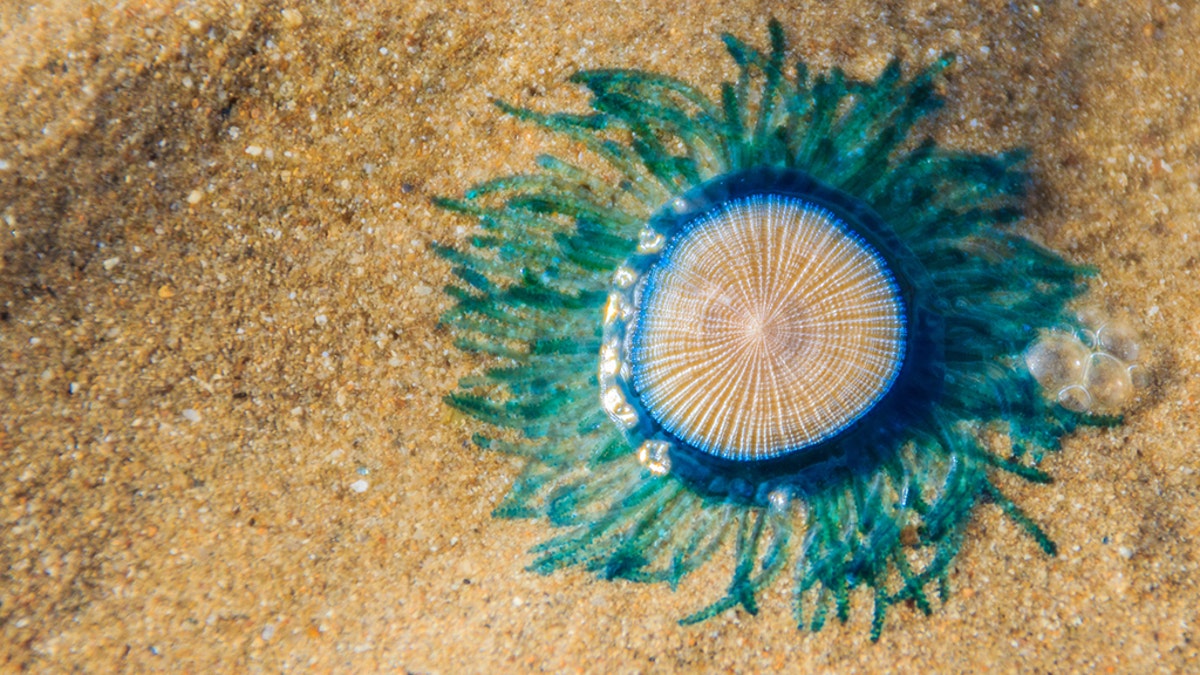
Blue button Jellyfish (porpita porpita) are washing up on New Jersey beaches after Hurricane Florence. (iStock)
New Jersey locals had to do a double take when they discovered nearby beaches were littered with bright blue sea critters. The odd-looking creatures were shades of green and blue and had long, dark tentacles.
Upon closer inspection, residents believed they were jellyfish — though they were unlike anything they'd seen before. They were later identified as "blue button jellyfish," a disc-shaped, free-floating organism that typically measures about 1-inch in diameter.
“They were so vibrant, it was unreal so I couldn’t help but stop and take notice," said Suzanne Schenker, who was walking along the coast of Beach Haven when she spotted a pair of the jellyfish, told WCBS-TV.
Schenker posted photos of the round creatures on "New Jersey Jellyspotters," a Facebook group with roughly 800 members.
GIANT 'CONTRACTING' CREATURE ON BEACH STUNS FAMILY: 'IT'S ALIVE'
"They even left a turquoise stain on the sand. I’ve never seen them before," Schenker said in the post.
Marine biologist Paul Bologna, a biology professor at Montclair State University, commented on Schenker's post, confirming they were — in fact — porpita porpita, also known as blue button jellyfish. Bologna said powerful winds from Hurricane Florence probably pushed the tropical jellyfish north.
"It's the first time I've ever seen one in New Jersey," Bologna told NJ Advance Media, explaining they were likely blown in from the Gulf Stream. "I've seen them in Florida but never this area. They are beautiful and stunning."
It didn't take long before others started updating locals with sightings of their own.
"Blue buttons wash up on Brigantine Beach, north end, New Jersey. If anyone sees them anywhere else, please let me know? Thanks! I just found this interesting," Holly Horner, of Williamstown, posted on Facebook, along with a picture, last Tuesday.
Another resident, Bernadette Brennan-Brudon, said she also saw blue buttons on Brigantine Beach last week.
"Is this different from the blue jellies that were spotted in Beach Haven last week?" one Facebook user asked.
Bologna clarified they're the same species, but it appears many more are washing up on the beaches in recent days.
MYSTERIOUS FUR-COVERED SEA 'MONSTER' WASHES UP ON BEACH: 'COULD IT BE SOME ANCIENT CREATURE?'
Blue button jellyfish are often compared to Portuguese man of-war, though they pack a considerably less powerful sting.
"Each is actually a colony of organisms that drift where the wind and currents send them. Each type of animal in the colony serves a specialized function for the survival of the colony," the National Park Service describes online. "While small, free-floating marine animals, known as zooplankton, are captured by the Blue button’s tentacles, humans are fortunately unaffected by its mild sting."
If residents spot any more blue buttons, Bologna asks that they store them — in a jar of ethanol, or in a Ziploc bag or jar with rubbing alcohol — so researchers at MSU can collect DNA samples.
"If you get several, we would love to get as many as possible for analysis," he added.